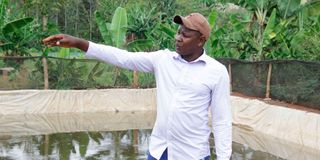Chief takes ornamental fish route

Wilfred Waichigo during an interview at his farm at Thuci village in Nyeri county on November 11. Below: One of the ornamental fish varieties on Savannah Farm.
At the border of Wilfred Waichigo’s farm in Mukurweini, River Sagana flows effortlessly separating Nyeri and Kirinyaga counties.
We arrive in Thuchi village and find him inspecting his ponds and harvesting fish.
“This is Savannah Ornamental Fish Farm. We have 21 ponds hosting about 13 species of fish for sale,” he says.
Waichigo started the farm in 2011, taking advantage of the Economic Stimulus Programme, a government project that was making ponds for farmers and supplying them with fish.
He did not make much from his harvest due to lack of knowledge and support from extension officers. The fish became too many and died.
Waichigo abandoned table fish farming in favour of other “lucrative” ventures like horticulture.
“I dug the second pond in 2014 and ventured into ornamental fish. The business became profitable 2018 after intensive marketing on social media,” he says.
The ponds vary in size, with most measuring 10x6 and 7x20 metres.
According to Waichigo, the cost of rearing ornamental fish is significantly low and the venture is not labour intensive.
He gained knowledge on ornamental fish by attending workshops and educating himself on the internet.
From the farm, Waichigo transports the fish to Nairobi, Mombasa, Nakuru, Eldoret, Machakos, Kitui, Malindi and other towns. He has set sights on Kisumu.
Colour richness
Social media has been of help as that is where Waichigo gets most of his customers.
Some have never set foot on the farm but rely on referrals and Facebook posts.
They buy the fish for aesthetic purposes and make aquariums for them at home, their places of work, hotels and hospitals.
“We charge prices for the fish ordered and courier fee,” he says.
Once an order has been placed, Waichigo puts the fish in a plastic bag packaging material that is tied on both ends. He then puts some water and oxygen to reduce mortality.
The fish are placed in cartons and transported by courier.
When not working on the farm, Waichigo serves as the assistant chief of Mukurwe-ini Central and delegates the pond chores to his wife.
“The fish only require feeding twice a day,” he says.
He uses pipes to drain water from the ponds during cleaning, usually after every two months.
The fish in the ponds are Koi carp, gold fish, black moore, black Molly, gold dust mooly, sword tail, fancy guppies, Gourami, zebra danios, luminous danios, angel, convict cichlid and platy.
The price per inch ranges between Sh100 to Sh300, save for gold fish which sells at Sh30 per inch.
Depending on the richness of the colour, Koi carp can sell at a higher price.
“Most of the ornamental fish I have in stock are not common. That gives me an edge over other farmers,” he says.
According to Waichigo, his stock has life bearers and egg layers.
The layers are injected with a hormone.
“We begin by cleaning up the ponds and injecting the hormones at night. After four days, the eggs have been hatched,” the administrator says.
From day one, he gives his fish starter feeds, which are in powder form. It is also given to catfish and tilapia.
They are his preferred feeds as they have a high protein content.
As the fish grow, the feed changes to those that are granular. Later the fish are fed on pellets.
The biggest challenge to Waichigo’s venture is predation, especially by the kingfisher bird and frogs.
To protect the fish, the farmer uses a net.
The administrator wants devolved and national governments to support ornamental fish farmers.
“Focus is mainly on table fish farming yet there are very many opportunities that should be tapped in the value chain of ornamental fish,” he says.
Apart from liners being expensive, the farmer at times imports feeds, saying the available locally produced ones are of low quality. A kilogramme goes for Sh450 for starter feeds.
Henry Kinyua, an agriculture expert, says with dwindling fish in natural water bodies, aquaculture can fill the gap and make it possible for regions without lakes, seas or oceans frontage to produce fish for consumption as well as business.
“Ornamental fish is part of business. Through aquaculture, farmers can produce many species of fish for consumption and ornamental purposes,” the agriculture expert says.





